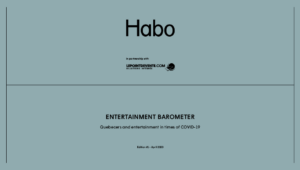Quebecers and entertainment in times of COVID-19 (edition 3, July 2020)
August 3, 2020

In April 2020, Habo and Lepointdevente.com published the first edition of Entertainment Barometer, a longitudinal study that analyzes the evolution of attitudes of Quebec entertainment consumers in relation to the current pandemic. A second edition, published in May 2020, focused on mitigation measures that could help bring back consumers to entertainment activities.
The third edition of Entertainment Barometer studies Quebec entertainment consumers from a new angle. We have seen that the consumer’s socio-demographic profile (and the age element in particular) has a significant influence on their current level of anxiety, and therefore, on the speed of their return to entertainment consumption. However, this perspective remains one-dimensional. It’s easy to see why by looking at two hypothetical Quebec entertainment consumers, both 34 years old:
- our first example is a mother of two, who is mainly interested in family entertainment activities and is worried about her children’s safety with COVID-19.
- the second is a single professional, someone who lives for Happy Hours and clubbing and is not discouraged at all by the virus.
These are two consumers with a similar socio-demographic profile, but with diametrically opposed attitudes both to entertainment and to the pandemic. To mitigate the effects of such disparate views within the same profile, the Habo team has developed a new approach to behavioral segmentation for entertainment consumers in Quebec. We analyzed a multitude of factors and discovered that two dimensions can help to group consumers into segments with similar behavior:
- their frequency of entertainment consumption and, above all, how important having entertainment in their lives is to them.
- their current level of concern about COVID-19 (whether that relates to their own health, that of their loved ones, their financial situation, or the economy as a whole).
The Result
We identified five unique and distinct segments that encompass all aspects of the consumer profile: socio-demographic, entertainment consumption, and the impact of COVID-19.
For each segment, we analyzed the mitigation measures that most influence consumers’ return to entertainment. In addition, since online events have experienced strong growth in recent months (see our analysis here), we also measured the performance of online events among those in each segment.
What can this segmentation be used for? What can be done with the learning it yields?
- First, let’s keep in mind that the two main segments in terms of volume of consumers (Socials and Occasionals) are segments with a low level of engagement with entertainment. Of course, they consume it, but entertainment activities are not the highest priority in their daily lives. Those for whom entertainment is central represent a third of the market, which is divided into two segments: Aficionados and Partiers.
- Each type of entertainment attracts one or more different consumer segments. Occasionals consume more “intellectual” entertainment (e.g. museums, classical music) than other segments, while Partiers are fans of nightclubs and sporting events. Thus, depending on the type of entertainment, this segmentation should influence recovery strategies—from marketing targeting to the mitigation measures put forward.
- Those who consume entertainment activities frequently and abundantly will return, and probably quite quickly. The challenge will lie in bringing back those for whom entertainment is less important, such as the Occasionals, or the Socials), but there is also a need to attract other segments too, people who may not have been seduced by certain entertainment value propositions before COVID-19. A mix of events could help here. For example, music evenings or Happy Hours can encourage some Partiers to visit museums.
- Human behavior is characterized by what cognitive science calls the “bandwagon effect”, a tendency of people to adopt a certain behavior, style, or attitude simply because others are doing it. This suggests that if consumers with the highest level of concern see other segments returning to entertainment consumption, they will feel reassured. Thus, entertainment destinations must find solutions to bring back the least worried segments (Aficionados, Partiers) to reassure those who are more worried (Families, Occasionals).
- For all segments, flexibility is key. Consumers want to know that the terms of any purchase they make will allow them to easily modify or cancel their booking. This is the mitigation measure that is most likely to influence their purchase. Therefore, entertainment organizations must look at solutions that allow them to offer total flexibility to their customers.
Do you want to know more?
A detailed report of the study is downloadable below.
For any additional information, you can contact us here.
Methodology
This study was conducted online with 1,009 people living in Quebec, selected at random among ticket buyers of the Lepointdevente.com website since 2017. Data was collected between June 16 and 30, 2020. Quotas were established to build a sample comparable to the structure of the Quebec population in terms of gender, age and region of residence.
Acknowledgments
This study is produced in partnership with Lepointdevente.com, and with the participation of Qualtrics.
Graphic design by Valerie Paquette.
 Download the study
Download the study


